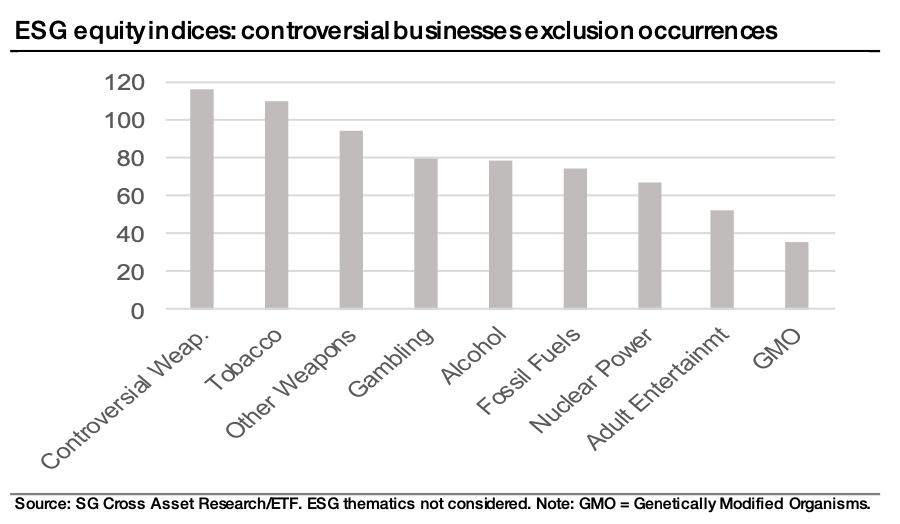There is a lack of consensus across the variety of different players in the ecosystem ranging from data providers to ETF issuers when it comes to implementing environmental, social and governance (ESG) exclusions.
A recent ESG directory issued by Société Générale highlighted this distinct lack of consensus among index providers over which industries to exclude from their indices.
Beyond controversial weapons and tobacco, where there is at least a large degree of agreement, the data for exclusions of other controversial areas such as alcohol, fossil fuels and genetically modified food producers is much patchier.

A first question is obvious; why is there is no consensus? A second and related question then arises; does this lack of consensus matter? The answer to both questions is nuanced.
This might seem obvious considering how quickly ESG-style investing has risen to prominence but questions around a lack of consensus are symptomatic of how ideas ESG investing are still evolving.
“Global norms change overtime as societal understanding of the issues evolves,” Narina Mnatsakanian, director for impact and responsible investment at Kempen Capital, says.
“For example 10-15 years ago very few indices excluded tobacco whereas now it quite normal. Carbon screens are also relatively new but over the next years they will become a lot more widespread.”
Timo Pfeiffer, chief markets officer at Solactive, highlights how ideas around ESG can vary dramatically depending on which country an investor is based. “For example, nuclear energy has a different reputation and approval among the general public in France than in Germany.”
Investors’ views on ESG will differ by investor type, region, institutional background and the goals of the mandate. Layer this on top of the differences between provider screens – as Pfeiffer points out, what exactly does constitute an exposure to tobacco? – and it becomes clear that different providers will inevitably screen out different companies.
It takes a village
Now we turn to whether the profusion of ESG index approaches and company considerations problematic? Not according to Vitali Kalesnik, head of research for Europe at Research Affiliates, who points out that one of the motivations of ESG investors is to attempt to influence companies to act in accordance with their own ideals.
But these ideals are very individual. “Because investors are all different it is natural that there are multiple offerings addressing the natural variation in investor preferences,” he says.
The individual nature of ESG investing explains why there has been an explosion of indices as providers are looking to capture the different ways to slice and dice the market.
“It is not a problem per se that different indices exclude different sectors as long as investors can choose,” Mnatsakanian, adds.
Yet, in attempting to sway companies, the more investors pool their own assets, the greater the influence they will have collectively.
“The more assets will be tracing strategies with some specific ESG preferences the stronger the impact on the company this strategy will have,” Kalesnik continues. “From that perspective, it is crucial for investors to combine assets into a consensus ESG definition.”
An obvious area where consensus is forming – though it is not there yet – comes with carbon screens. Kalesnik says two forces are combining here to some effect; increased public concern over the environment and the greater willingness of governments to work on a global level. Citing the Paris Agreement, he suggests that “public funds are reacting to these pressures and to the accompanying legislation”.
As Pfeiffer suggests, addressing the climate change problem is an area where we can see the first signs of regulatory intervention in order to guide towards benchmark standardisation, an area where he believes we will see further action.
The European Commission developed two benchmarks last year in a move to introduce new standards on climate change. In response, index providers have launched indices in line with these new standards.
“The ESG conversation is rapidly evolving and maturing,” Kalesnik adds. “As the industry matures, we will see a lot more concerted effort around the definitions which will address the interests of the majority of investors.”
Proliferation
Yet while greater standardisation might be, as Pfeiffer suggests, “one outcome” from further regulatory moves, on the supply side the proliferation of data suppliers in the ESG space rather points in the opposite direction. “The market is not monopolistic on either the supply side or the demand side,” he says.
In the case of the latter, the various data consumers such as asset managers, banks, and index providers all choose different data providers for different mandates. The two largest data providers, Sustainalytics and MSCI, for example, have a correlation of just 0.5 on their ESG data scores.
The lack of consensus among ESG data providers has given rise to the concept of greenwashing, the practice of misleading investors into believing a product is more sustainable than it is.
Tackling greenwashing has been at the top of European regulators’ agendas and the lack of standardisation can enable providers to label their products as ESG when they are not.
The European Union introduced new disclosure requirements in 2018 to help tackle this issue while the Financial Conduct Authority has said it is an active area of focus.
Detlef Glow, head of EMEA research at Lipper, commented: “Nevertheless, even as these new standards are a step in the right direction, it is already clear that they will not be sufficient to eliminate all hindrances and greenwashing, so that it is foreseeable that these standards will be extended in the future.”
ETF Insight: Are ETF and index providers taking ESG seriously?
Meanwhile, advances in technology are changing the nature of the data supplied.
“It is noteworthy that new data points and new ways of data gathering and measurements (e.g. Artificial Intelligence) become available at a quite rapid pace, such that there is always a gap for a new, young company to fill.”
Of course, the ultimate answer to whether a lack of consensus represents an issue for the ESG sector comes via the data on assets under management. And as the SG directory makes plain, up until the first quarter of this year it is hard to make the case that it has acted as any kind of retardant.
As the report states, as of mid-April ESG ETF funds under management has hit $71bn with 229 ETFs in the US and Europe providing access to 204 different ESG indices. Consensus may be lacking but investor enthusiasm clearly is not.
Sign up to ETF Stream’s weekly email here


